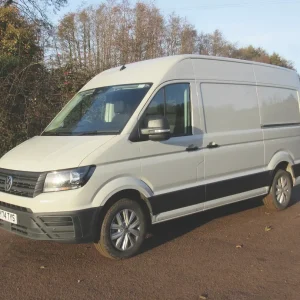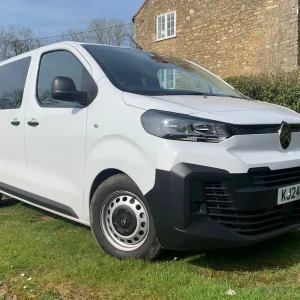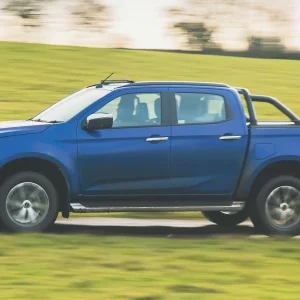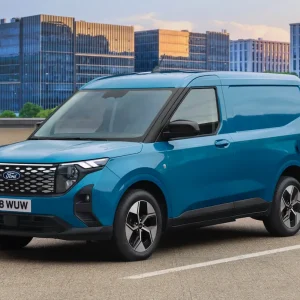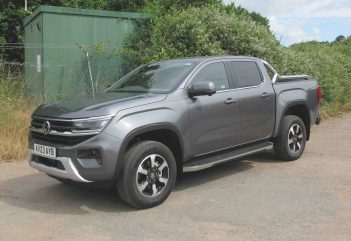
After an absence of three years, Volkswagen’s Amarok 4×4 pick-up is back in the UK – but the newcomer is a somewhat different proposition to that of its predecessor. Ever-closer ties between VW and Ford mean that the latest Amarok is based heavily on the latter’s Ranger pick-up platform, but with different styling cues.
Aside from the badges, VW’s offering is distinguished by flat-topped wheel arches, a high waist and a differently-styled radiator grille. For your money you also get narrow LED headlights and C-shaped rear lights.
Unlike the Ranger, the Amarok 4Motion is marketed solely as a double-cab. Under the bonnet you will find a 2.0-litre TDI diesel engine at either 170hp or 205hp or a 3.0-litre TDI V6 pumping out 240hp.
Four specification levels are up for grabs; Life, Style, PanAmericana and top-of-the-pile Aventura.
The 170hp unit is available solely with entry-level Life trim and comes with a six-speed manual gearbox as standard. All the other models are supplied with a standard 10-speed shift-by-wire automatic box.
Bear in mind that the undoubtedly-opulent Aventura’s payload capacity falls under the vitally important 1.0-tonne threshold. As a consequence business owners cannot reclaim VAT on the vehicle.
We elected to get to grips with a 205hp model built to Style specifications. Here’s how we got on.
Load bay
Access to the cargo box, which sits on a ladder frame chassis, is by means of a lockable tailgate which drops down horizontally. As with all modern purpose-bult pick-ups, a bulky rear bumper – which incorporates a step – prevents it from dropping down completely.
Six load tie-down points are provided plus a styling bar which sits above the load bay. Gross payload capacity is a VAT-efficient 1,060kg, while braked trailer towing capacity is an impressively-beefy 3.5 tonnes.
The VW logo plus the embossed ‘Amarok’ name would make sign-writing the tailgate something of a challenge. The cheap and tacky-looking ‘4Motion’ stickers on the body’s sides would get in the way too and should be removed.
Interior and equipment
A big 12-in vertical touchscreen dominates the centre of the dashboard of what is undoubtedly a well-equipped truck, and controls many of the in-cab functions; although thankfully some of them are still controlled by physical buttons. It is complemented by a 12in digital instrument panel.
The infotainment package embraces a DAB+ radio, Android Auto and Apple CarPlay plus VW Connect Navigation.
Dual-zone climate control is included in the deal as are front foglights with a cornering function. IQ.Light LED matrix headlights are fitted to Style, PanAmericana and Aventura and provide a high standard of nocturnal illumination.
So are a 12v socket and a pair of USB ports along with an inductive charging pad for your smartphone.
A keyless ignition system is fitted along with an electric parking brake and reversing sensors. The vision provided by the reversing camera is exemplary and we can only applaud the 360° birds-eye view which alerts you to any potential hazards around the vehicle when you are manoeuvring.
In line with VW’s well-established policy, the Amarok Style is packed with plenty of other on-board safety and driver assistance devices, including adaptive cruise control.
The line-up further embraces lane assist, which stops you wandering out of lane; a side assist lane-change system that warns you if vehicles are on course to enter your blind spot; and dynamic road sign display. Installed, too, is park assist with park distance control, which helps you manoeuvre into a parking space, and rear traffic alert, which triggers a warning if you are about to reverse into the path of an oncoming vehicle.
Perhaps the most important safety feature, however – and one that is found on all Amaroks – is autonomous emergency braking front assist with pedestrian and cyclist monitoring. It alerts the driver if they are about to run into something or somebody, and applies the brakes if no action is taken.
Electronic stability control is present too along with front, side, curtain and knee airbags.
Electric windows are installed in all four doors and the heated exterior rear-view mirrors are electrically-adjustable. They fold in automatically and groaned in protest every time they did so on our demonstrator, prompting us to look for our trusty spray-can of WD40.
The driver’s seat can be adjusted 10 ways electrically, and that of course includes the ability to alter the height. The leather-trimmed steering wheel is height-adjustable too, so most people should be able to find a comfortable driving position.
The front passenger seat offers eight different electric adjustments.
Storage facilities include a big lockable glove box with a second compartment above it, a roomy lidded bin between the two front seats along with a couple of cup-holders and a tray on top of the dashboard. You will find a holder for your sunglasses just above the windscreen and all the cab’s doors boast a bin and a cup-holder.
Turning to the rear seat, there is a decent amount of room for the outboard passengers with more legroom than was on offer in the old Amarok, which had a shorter wheelbase and was shorter overall. The middle passenger doesn’t fare too badly either, although shoulder room remains a little tight with three occupants in place.
With just two on board the back of the middle seat can be folded down and transformed into an armrest with a pair of cup-holders.
Whoever is travelling in the back can avail themselves and make full use of a 120v/230v outlet in the rear of the console between the two front seats.
The cab is graced with side steps and our truck’s 18in alloy wheels were shod with Goodyear Wrangler Territory HT 255/65 R18 tyres. Tyre pressure monitoring keeps an eye on them and a full-size steel spare wheel is provided.
Powertrain
Equipped with common rail direct fuel injection and variable turbocharger geometry, the Amarok’s BiTurbo in-line four-cylinder diesel delivers its maximum power at 3,750rpm. Top torque of 500Nm bites across a 1,750rpm-to-2,000rpm plateau.
AdBlue is required to keep the Amarok compliant with the Euro 6 exhaust emission rules. The filler point for the 19.3-litre AdBlue reservoir is next to the diesel filler point under a flap on the offside of the vehicle.
Driving
While our Amarok would never be able to surge away from rest at quite the pace of its V6 stablemate, with 200hp-plus on tap it is certainly no slouch, delivering strong acceleration and relaxed cruising. Much of that is due to the quality and competence of the gearbox, which delivers an exceptionally-smooth change as it slides from one set of cogs to the next.
The truck handles well too, swinging with ease through one rural bend after another thanks in part to its new electromechanical power steering, but in-cab noise levels are a tad too high and its unladen ride is uneven to the point of being downright lumpy. The rear suspension features leaf springs while the front employs MacPherson-type struts, and the whole system may require a rethink.
The Amarok comes with a drive mode control system.
While eco mode was tempting from the fuel economy viewpoint, we stuck with normal that we felt delivered the best overall performance. Other modes assist driving in muddy, sandy or slippery conditions, or if you are towing a trailer.
Press the ‘M’ button on the side of the gearshift and you can go up and down the gears manually using the plus and minus buttons. One suspects that most drivers will only choose the manual option if they venture off-road; and if they do so, they will discover that four-wheel-drive is easy to engage.
All you need to do is twist a knob between the seats and select it with either a high (4H) or a low (4L) set of gears. You need the latter if you are about to engage in some serious mud-plugging.
The 4A setting that is also available confused us somewhat. What it does, however, is give you extra traction on ordinary roads if they happen to be hazardous due to ice and snow; a useful facility.
Grab-handles on the A and B pillars give the passengers sitting closest to them something to hang onto if the offroad going gets rough. They’re accompanied by grab-handles above all the door apertures.
With shorter overhangs than the old model, the Amarok’s performance off-road is commendable.
Wading depth has gone up by 300mm to 800mm, which gave us a bit more confidence when we crossed streams, although the warm, dry conditions we encountered when we drove the truck meant that they were running at a trickle rather than a torrent. Steep rutted farm tracks with the occasional boulder were tackled with ease, with little need to resort to 4H.
A week or two later and we would have been sloshing through thick mud and battered by heavy rain; but we’re confident Amarok would have coped.
Operating
The Amarok is protected by a five-year/ 124,000-mile warranty with roadside assistance for the entire duration. The paintwork warranty lasts for five years – longer than is usual – as part of what VW refers to as the ‘5+ Promise’, which means the first five services and three MoT tests are included in the price.
Service intervals are set at two years/12,500 miles – whichever is sooner. The body is warranted against corrosion for 12 years.
Fuel economy is 32.1mpg under the WLTP (world harmonised light vehicle test procedure) combined cycle, but we achieved a little less at around 30mpg.
VW Amarok Style 2.0 TDI 4Motion 205hp 10-speed automatic double-cab pick-up
Price (ex VAT) £41,450
Price range (ex VAT) £33,000–47,000
Gross payload 1,060kg
Load length 1,624mm
Load width (min/max) 1,224mm/1,584mm
Load bay height 529mm
Loading height 876mm
Gross vehicle weight 3,280kg
Braked trailer towing weight 3,500kg
Residual value 40.9%*
Cost per mile 68.3p
Engine size/power 1,996cc, 205hp @ 3,750rpm
Torque 500Nm @ 1,750-2,000rpm
Gearbox 10spd automatic
Fuel economy (combined WLTP) 32.1mpg
Fuel tank 80 litres
CO2 229g/km
Warranty 5yrs/124,000 mls
Service intervals 2yrs/12,500 mls
Insurance group 42E
Price as tested £41,950
* after 48 months @ 20,000 miles a year – source – KWIKcarcost
Ford Ranger
Price range (ex VAT) £27,550–48,800
Gross payload 652-1,207kg
Braked towing weight 2,500–3,500kg
Engines 175hp, 205hp, 210hp 2.0 diesel, 240hp 3.0 diesel, 292hp 3.0 petrol
Verdict: There are two key differences between Ranger and Amarok. The former comes as a single cab, with more stress on entry-level specifications. It is also marketed in Raptor guise, with a petrol (yes, petrol) V6 engine with almost 300hp on tap. How does that square with Ford’s focus on battery-electric technology and zero-emissions? We love the petrol V6; so long as we’re not paying for fuel!
Isuzu D-Max
Price range (ex VAT) £23,004–49,640
Gross payload 1,045–1,205kg
Braked towing weight 2,500-3,500kg
Engines 164hp 1.9 diesel
Verdict: While we’ve got a lot of time for D-Max, there is no denying that it is falling way behind in the power stakes. Isuzu really needs to give some thought to offering a model with at least 200hp on tap if it is not to lose out to its rivals. It would be a pity if it did fall down because D-Max is a solidly-built truck. Packed full of safety features and backed by a dealer network, its ideally suited to supporting customers who require pick-ups for use as working tools rather than for leisure.
Toyota Hilux
Price range (ex VAT) £27,777–60,187
Gross payload 1,000–1,030kg
Braked towing weight 3,500kg
Engines 150hp 2.4 diesel, 204hp 2.8 diesel
Verdict: The biggest change Hilux has undergone in recent years is the long-awaited power boost it has received with the introduction of a 200hp-plus diesel. Its arrival was accompanied by the advent of an upgraded interior, a restyled exterior and a variety of useful mechanical changes. Noted for its durability, Hilux is without doubt a tough working tool, but one not short of creature comforts. Residual values should be healthy given that it has a reputation for being unbreakable.
The Final Verdict
Design 8/10 – Well-thought-out package that builds on the previous Amarok with improvements
Cabin 8/10 – Comfortable working environment with impressive space for rear passengers
Ride 6/10 – Too choppy when truck is unladen; suspension needs retuning for on-highway work
Refinement 7/10 – Too much interior noise, must be balanced with a sophisticated and high-quality interior
Load area 8/10 – Sensibly-designed, with enough space for a metric pallet between the wheel boxes
Handling/performance 8/10 – No quarrels with either, and its off-road ability should tackle most conditions
Engine/transmission 9/10 – An exemplary combination, the 10-speed automatic gearbox delivers a smooth change
Standard equipment 8/10 – Lots of kit with plenty of stress on safety
Operating costs 8/10 – Warranty and servicing package is worthy of applause, even with restrictions
What Van? subjective rating 8/10 – An upmarket double-cab 4×4 pick-up, rather than a pedestrian workhorse
Overall Rating = 78/100

